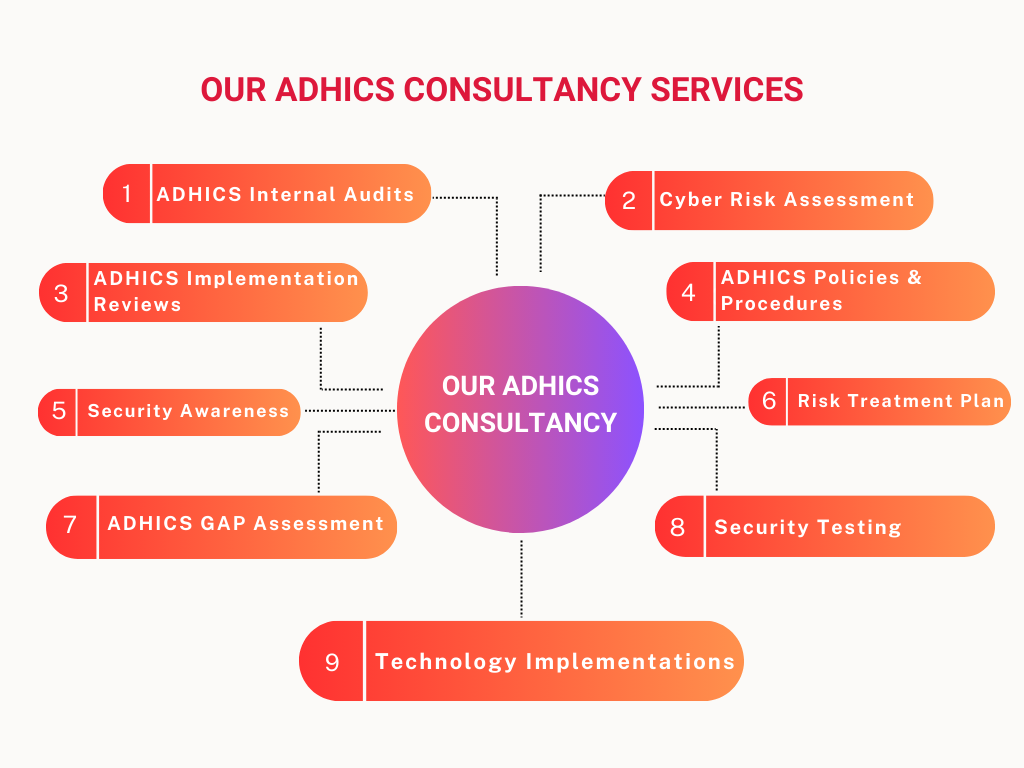Adhic Audit

What is ADHICS
ADHICS stands for Abu Dhabi Health Information and Cyber Security Standard. It is a comprehensive set of guidelines and regulations developed by the Department of Health (DoH) in Abu Dhabi to ensure the security and privacy of health information within the emirate’s healthcare sector. The standard aims to protect patient data from unauthorized access, breaches, and cyber threats by implementing robust information security practices.
Adhics Audit
5/5
ADHICS GAP Assessment
The ADHICS (Abu Dhabi Healthcare Information and Cyber Security) GAP Assessment is a structured approach to evaluate how well an organization complies with the ADHICS standards. This framework ensures the protection of healthcare information through robust cybersecurity measures..
4/5
Cyber Risk Assessment
Conducting a cyber risk assessment helps organizations proactively identify and mitigate risks, enhancing their overall cybersecurity posture and ensuring the protection of critical information assets. By following a structured approach, organizations can prioritize their security efforts and allocate resources effectively to address the most significant threats.
4/5
Risk Treatment Plan
A Risk Treatment Plan is a structured approach to addressing identified risks by selecting and implementing appropriate risk treatment options. This plan outlines the actions required to mitigate, transfer, accept, or avoid risks to achieve an acceptable level of residual risk.
5/5
ADHICS Policies & Procedures
The Abu Dhabi Healthcare Information and Cyber Security (ADHICS) standard is designed to ensure the protection of healthcare information through robust cybersecurity measures. Implementing ADHICS-compliant policies and procedures is essential for healthcare organizations to safeguard patient data and maintain regulatory compliance.
4/5
Security Testing
The Abu Dhabi Healthcare Information and Cyber Security (ADHICS) standard sets forth comprehensive guidelines to ensure the security and privacy of healthcare information systems. Security testing is a critical component of the ADHICS framework, aimed at identifying and mitigating vulnerabilities to protect sensitive healthcare data.
4/5
Security Awareness
By implementing a comprehensive security awareness program aligned with ADHICS standards, healthcare organizations can significantly reduce the risk of security breaches and enhance their overall cybersecurity posture. Educating employees about the importance of cybersecurity and equipping them with the knowledge and skills to protect sensitive information is crucial for maintaining a secure and compliant healthcare environment.
5/5
Technology Implementations
By implementing these technologies in alignment with ADHICS standards, healthcare organizations can significantly enhance their cybersecurity posture, protect sensitive patient data, and ensure compliance with regulatory requirements. These efforts not only safeguard the organization but also foster trust and confidence among patients and stakeholders.
4/5
ADHICS Implementation Reviews
Implementing the Abu Dhabi Healthcare Information and Cyber Security (ADHICS) standards requires a systematic approach to ensure compliance and effective cybersecurity measures within healthcare organizations. Here are some key aspects to consider when implementing ADHICS
4/5
ADHICS Internal Audits
Internal audits play a crucial role in ensuring compliance with the Abu Dhabi Healthcare Information and Cyber Security (ADHICS) standards within healthcare organizations. Here’s how internal audits can be conducted effectively
Phase 1 – Assessment
1
Identify Critical Assets
- Project Initiation
- Understand the organization
- Identify critical business services
- Identify information infrastructure
2
ADHICS Controls Identification
- Identify cyber security controls that can mitigate the risks in line with ADHICS Compliance requirements.
- Define ADHICS Risk Treatment Plan
3
Gap & Risk Assessment
- Inspection of current risk state using ADHICS Standard
- Discovering threats & vulnerabilities by exploiting the gaps
Phase 2 – Control Development
NESA Policies & Procedures
- Policies and procedures provide the base for executing cyber security best practices within the organization.
1
Security Awareness
- Humans are often considered the most vulnerable connection in cyber security. Security Awareness & Training provides them with adequate learning on cyber security.
2
Technology Controls
- Security Architecture
- Technology Gaps
- Configuration Advisory
3
Management Controls
- Operational Controls
- Physical Security
- Managerial Controls
4
Phase 3 – Security Services
Periodic Security Testing
- Vulnerability Assessments
- Penetration Testing
- Security Configuration Reviews
1
SIEM & Incident Response
- SIEM Solution Deployment.
- 24×7 Security Monitoring
- Security Device Management
2
Managed Network Security
- Next Gen Firewalls, UTMs
- URL Filter, Web Security
- Wi-Fi Security
- VPN and Remote Access Security
3
Data & Endpoint Security
- DLP Solutions
- Patch Management
- Endpoint Security
- Mobile Device Management
4
Phase 4 – Compliance Review
ISMS Performance Review
- Assess the performance of the ISMS against the defined metrics. It is a significant measure towards the continual improvement of the ISMS.
1
ISMS Internal Audits
- Perform periodic ISMS Audits to assess compliance with the defined policies and procedures
2
Mock Compliance Audit
- Perform Mock Compliance Audits that help you identify the weak areas of ISMS implementation.
3
External Audit Support
- Assist the customer during the Compliance Audit to meet the required ISMS requirements.
4
Data Privacy
Ensuring that patient information is kept confidential and is only accessible to authorized individuals.
Information Security
Implementing measures to protect health data from cyber threats and breaches, including encryption, access controls, and regular security audits.
Compliance
Healthcare organizations must comply with ADHICS to operate within Abu Dhabi, and they are subject to regular assessments to ensure ongoing compliance.
Risk Management
Identifying, assessing, and mitigating risks associated with the storage, processing, and transmission of health information.
Governance
Establishing clear policies, procedures, and governance structures to manage health information security effectively.
ADHICS is part of a broader effort to enhance the quality and security of healthcare services in Abu Dhabi, aligning with international standards and best practices in health information management and cybersecurity.

